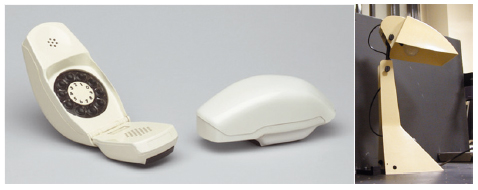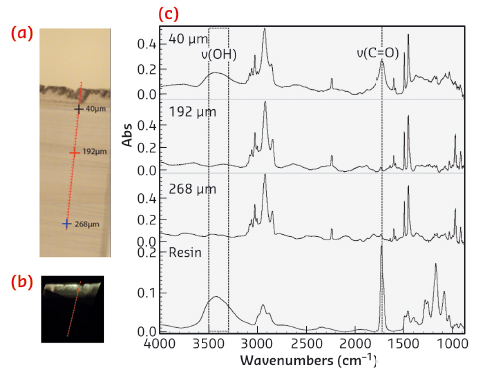- Home
- Users & Science
- Scientific Documentation
- ESRF Highlights
- ESRF Highlights 2014
- X-ray Imaging
- Micro-FTIR study of the polymer degradation in design objects
Micro-FTIR study of the polymer degradation in design objects
Recent developments in analytical chemistry are being put to good use in the study of artwork. Some analyses can be carried out directly on the objects, while in some cases, micro-fragments can be sampled, allowing a more accurate analysis of the material’s composition, at the micrometre scale. Care is needed in the preparation of these tiny fragments to reveal as much detail as possible of their intrinsic structure (usually multi-layer) and to preserve the chemical and physical properties of the sample. New preparation strategies have been recently developed at beamline ID21 for thin sections from painting fragments [1]. We report here their application to the study of the degradation of acrylonitrile-butadiene-styrene (ABS) polymer in historical Italian design objects [2].
ABS has been widely used over the last 50 years as a plastic material in industrial applications. It is present in many design objects and household items such as telephones, domestic appliances, lamps, musical instruments, some of which are now being exhibited in international museums. However, as observed with paintings, ABS suffers from photo-ageing, which leads to the alteration of its physical properties, chemical modifications such as crosslinking and chain scission, colour changes (yellowing and discolouration) and worsening of mechanical performance. The objective of this study was to characterise and assess the depth of alteration in terms of chemical modifications on two types of samples: artificially photo-aged ABS blocks and fragments from historical Italian design objects from the 1960’s [2] (Figure 72).
Fourier transform infrared spectroscopy (FTIR) is well suited to the characterisation of such materials since it probes molecular groups and allows the disappearance of the reactive groups and the formation of degradation products to be followed. In-depth analysis of such phenomena has already been reported, but limited by an in-depth resolution of about 100 µm [3]. The goal of the present study was to study transversal sections of the polymers with synchrotron-based micro-FTIR (at ID21), in order to locate the different components constituting the polymers, at the micrometre scale. This required the preparation of thin-sections (2 µm), sliced perpendicularly to the block surface. The sample fragment, smaller than 1 mm3 and representative of the entire stratigraphy, was clamped between two sheets of polycarbonate or polyether ether ketone foil, PEEK, (3 × 6 x 1 mm3). Thin-sections of different thicknesses were obtained using a microtome, at room temperature.
This method produced very thin samples with high surface quality while avoiding the use of embedding media and polishing or grinding; it solves the risk of chemical and analytical interference, both for IR and X-ray analyses.
 |
|
Fig. 72: Italian design objects made of ABS. (left) Grillo (Marco Zanuso and Richard Saper for Siemens), 1965; (right) E63 (Umberto Riva for Francesconi) 1963, Private Collection. |
On such a section, both the internal pristine polymer and the superficial products formed during photoageing can be identified and localised, in a single FTIR map. The visible image (Figure 73a) and UV fluorescence images (Figure 73b) highlight a luminescent upper layer of about 45 µm on the surface of an artificially aged block. In Figure 73c, three FTIR spectra from three different depths are shown: 40, 194 and 268 µm. When comparing surface and bulk areas, the spectra from the most external parts of the sample show a clear increase of the signal relative to C = O stretching in the region 1800-1600 cm1 and the appearance of an intense and broad signal relative to O-H stretching centred at 3436 cm-1. These bands were attributed to ketones, aldehydes, esters, α,β-unsaturated carbonyl, carboxylic acids and alcohols. The depth of oxidation in samples was also evaluated, for samples aged for different amounts of time. µFTIR highlighted a selective and progressive gradient of degradation, greatest at the surface of the sample and which decreases in-depth. The oxidation compounds tend to form a passivation layer, limiting further oxidation of the bulk ABS [2].
 |
|
Fig. 73: SR µFTIR study of the oxidation of an ABS model film (sample exposed to UV-irradiation for 1000 hours); a) Visible light microscope image of a 2 µm thin-section, b) UV light microscope images of 1000 hour aged ABS sample on the left, and of pure resin thin-section (2 µm) on the right c) FT-IR spectra acquired at different positions corresponding to three different depths from the sample surface and one spectrum characteristic of the absorption of an embedding resin, prepared as a 2 µm thin-section. |
To illustrate the strength of this sample preparation protocol, Figure 73c includes the spectrum of a standard embedding resin (Historesin, Leica), showing strong overlaps with FTIR bands characteristic of the chemical bonds formed during photo-ageing. Identification and precise localisation of these degradation compounds would have been difficult or even impossible using a standard resin embedding protocol.
Authors
E. Pouyet (a,b), M.Cotte (a,c), A.Nevin (d) and D. Saviello (e).
(a) ESRF
(b) ARC-Nucléart - CEA/Grenoble (France)
(c) Laboratoire de Physique des Solides, UMR 8502 Université Paris Sud, Orsay (France)
(d) Consiglio Nazionale delle Ricerche – Istituto di Fotonica e Nanotecnologie (CNR-IFN), Dipartimento di Fisica, Politecnico di Milano (Italy)
(e) Dipartimento di Chimica Materiali e Ingegneria Chimica, Politecnico di Milano (Italy)
References
[1] E. Pouyet et al., Analytica Chimica Acta 822, 51-59 (2014).
[2] D. Saviello et al., Analytica Chimica Acta 843, 59-72 (2014).
[3] J.G. Bokria and S. Schlick, Polymer 43, 3239-3246 (2002).



